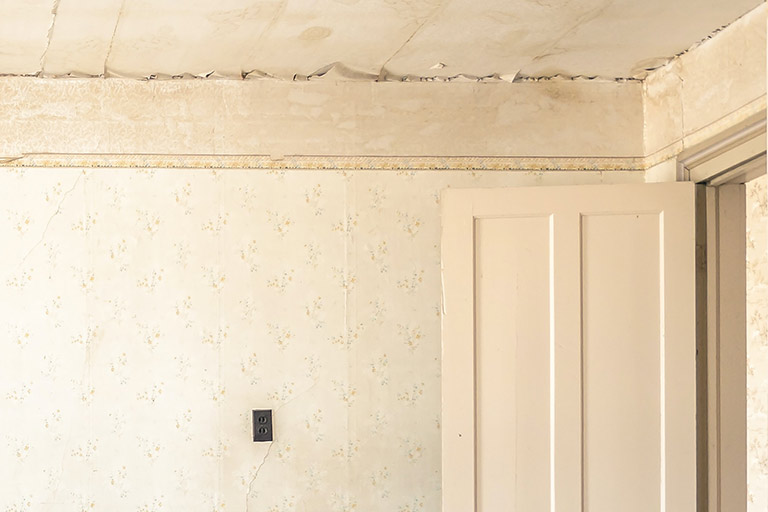Walking into a room and noticing cracks in your ceiling can be quite unsettling. These unsightly blemishes not only affect the aesthetics of your home but can also indicate underlying issues that need attention. In this article, we will delve into the various reasons why cracks appear in your ceiling and explore the solutions to rectify this common problem.

Common Causes of Ceiling Cracks
Cracks in the ceiling can emerge from a variety of factors. It’s essential to comprehend the root causes to determine the best course of action for addressing the problem. Here are some of the most common causes:
1. Natural Settlement
One of the primary reasons for ceiling cracks is the natural settlement of your home. Over time, houses tend to settle as the ground beneath them shifts. This settling can lead to structural adjustments and, in turn, result in cracks in the ceiling. These cracks can vary in size, from small hairline fractures to more noticeable gaps. If you suspect settlement-related issues, consulting with a professional to assess the extent of the problem is crucial.
2. Temperature and Humidity Changes
Fluctuations in temperature and humidity levels can also contribute to ceiling cracks. This is especially prevalent in regions with extreme climate variations. When temperatures rapidly change, the materials in your ceiling expand and contract, causing stress on the structure. Over time, this stress can manifest as visible cracks. Adequate insulation and climate control can help mitigate these issues.
3. Roof Problems
Roof issues can be a prominent cause of ceiling cracks. Leaky roofs, whether due to damaged shingles, inadequate flashing, or other problems, can allow water to infiltrate the attic space. Over time, this water damage can weaken the materials in the ceiling, making it more susceptible to cracking. Ensuring your roof is well-maintained and promptly addressing any leaks is essential to prevent this damage.
4. Poor Workmanship
In some cases, this damage can be traced back to poor workmanship during construction or renovation. If the materials used are subpar, or if the installation was not executed correctly, cracks may develop over time. Insufficient support, uneven drywall installation, or other construction flaws can lead to structural weaknesses that eventually result in cracks.
5. Heavy Loads and Vibrations
Ceilings can develop cracks if subjected to heavy loads or excessive vibrations. This can happen in areas with constant foot traffic above or near construction zones. If you suspect that these external factors are causing the cracks, taking steps to minimize heavy loads and vibrations can help preserve the integrity of your ceiling.
Solutions for Ceiling Cracks
Now that we have explored the common causes of this damage, let’s discuss potential solutions to address this issue:
1. Professional Inspection
Upon noticing cracks in your ceiling, the initial step is to consult with a professional. Experienced contractors or structural engineers can assess the situation, identify the root cause, and recommend appropriate repairs. They can determine whether the cracks are cosmetic or indicative of structural issues, helping you make an informed decision on the necessary action.
2. Repairing Minor Cracks
For minor, primarily cosmetic cracks, you can often address them with simple repairs. This may involve patching the cracks with spackling or joint compound and subsequently repainting the affected areas. However, keep in mind that this approach may not resolve underlying structural issues.
3. Addressing Roof Problems
If roof-related issues are causing ceiling cracks, addressing the root of the problem is essential. Repair or replace damaged shingles, fix flashing issues, and ensure your roof is watertight. This will help prevent further water damage and, in turn, ceiling cracks.
4. Proper Maintenance
To prevent future ceiling cracks, performing regular maintenance on your home is crucial. Conduct routine inspections of your roof, check for leaks, and address any problems promptly. Maintaining a stable indoor climate can also help reduce temperature-related stress on your ceiling.
5. Structural Reinforcements
In cases where structural integrity is compromised, additional reinforcements may be necessary. This might involve adding support beams or implementing other measures to enhance the stability of your ceiling.
Conclusion
Cracks in your ceiling can be disconcerting, but they don’t have to be a cause for alarm. By understanding the underlying causes and seeking professional guidance, you can effectively address the issue. Whether through minor repairs, addressing roof problems, or implementing structural reinforcements, you can ensure that your ceiling remains free of cracks and your home maintains its structural integrity. If you encounter this damage, take action promptly to protect your investment and maintain the beauty of your living space.